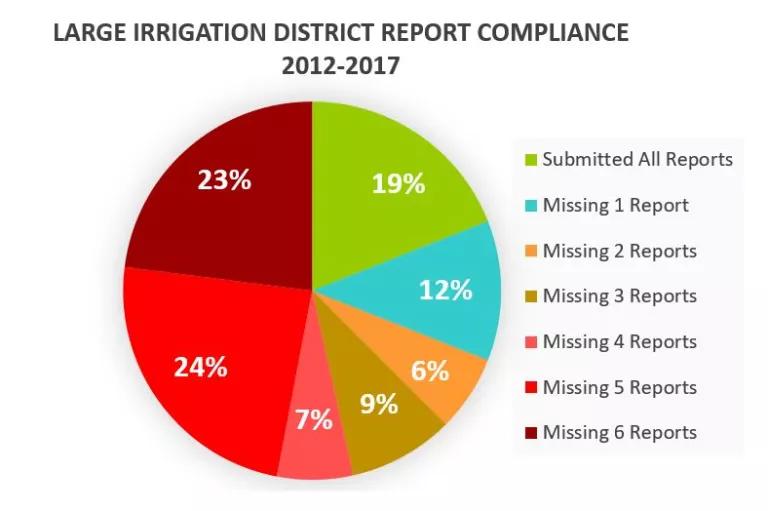The Problem with California's Watered Down Farmgate Data

It’s World Water Day! As we celebrate this life giving resource, and work to end the inequities in accessing it, I want to highlight one important tool Californians have to better understand how water is used in the Golden State: Farmgate Delivery Reports (FGDR). Even though the law requires these reports, too many are missing. Water data is a public resource, and the agency responsible for collecting FGDRs, the Department of Water Resources (DWR) is not doing enough to fill the water use data gaps that result from those missing reports.
What Is a Farmgate Delivery Report?
A farmgate delivery report is a one-page form that some irrigation districts are required to submit annually. FGDRs detail how much water an irrigation district supplies for agricultural use on a monthly or bimonthly basis, how many farmgates are measured, and the size of the service area. A farmgate is the physical point at which an irrigation district diverts water to a farm (see below).
What’s the Status?
In June 2018, NRDC published a report that showed disturbing levels of noncompliance with farmgate delivery reporting—only 12 percent of the state’s largest irrigation districts submitted all of their required FGDRs from 2012 to 2016. A lot has happened since that report was published: 2017 FGDRs have been submitted and a new law was enacted, AB 1668. Supported by NRDC, the law requires DWR to update its web infrastructure so that FGDRs can be filed electronically and available online. Has the new law helped increase compliance? NRDC analyzed newly available data, and here’s what we found:
- Yearly compliance is up. 38 percent of the state’s largest irrigation districts submitted their 2017 reports, up two percent from those irrigation districts who submitted their reports in 2016. That said, 62 percent of reports are still missing for 2017.
- Data are more comprehensive. When NRDC did its initial analysis, too many reports did not have farmgate information and others had incomplete monthly/bimonthly totals. With the new online database, 114 old reports were either resubmitted or manually updated to include new information (e.g. # of farmgates measured, total number of farmgates, total service area acreage, total water delivered in the year). And, as of today, DWR’s online database has 21 previously not submitted or publicly unavailable FGDRs.

- Total compliance is improving. 18 percent of the state’s largest irrigation districts have submitted all their FGDRs from 2012-2017, up six percent from the publication of NRDC's report. Make no mistake, 18 percent total compliance is still very low, and a significant number of reports are still missing (as shown in the percentage breakdown to the right).
You may be thinking, ‘Okay, I thought things were getting better, but the pie chart shows that lots of reports are still missing. Should I care that irrigation districts aren’t submitting their FGDRs?’ Yes, and here’s why:
- Data
The California Department of Water Resources (DWR) is the agency responsible for managing water resources in the state, but the agency cannot effectively manage what it does not measure. As the Legislature noted in Section 1 of the bill that created the reporting requirement, “A greater understanding of water use will support better decisions related to water planning, water allocations, water transfers, and water use efficiency.” FGDRs provide DWR with a better understanding of water use in the state. The monthly and bimonthly breakdowns of water supplied show trends in water distribution across irrigation districts and across years. There is value in data, and for DWR to reap the full benefits of the data provided in FGDRs, the data need to be thorough and accurate. This can only happen with full compliance to the reporting requirement. - Pricing & Accountability
The state’s largest irrigation districts are required to implement pricing structures that are based, in part, on the amount of water delivered. The FGDRs allow DWR to have conversations about pricing structures with irrigation districts. For example, if the water delivery volumes for a district are increasing every year, DWR could work with that irrigation district to recommend a volumetric pricing scheme that adequately reflects the uptick in water distribution. Making the water delivery volumes publicly available also helps empower farmers to keep their irrigation districts accountable for the water delivered to their farms. - Infrastructure Upgrades
The publicly available data helps scientists, agricultural technology entrepreneurs, and advocates think about ways to promote on-farm, and district-wide, water efficiencies. By analyzing water volume delivery data, advocates can better identify where financial assistance, infrastructure investments, policy opportunities, and pilot programs can help the state achieve its goals of Making Water Conservation a California Way of Life.
So now that you know more about farmgate delivery reports, why noncompliance to the reporting requirements is a problem, and the status of the reports, you may be asking, ‘What now?’
Last year’s bill helped move reporting into the 21st century, but the data gaps in farmgate delivery reporting need to be addressed. This year, Assembly Member Friedman introduced AB 1415, which authorizes DWR to enforce penalties against irrigation districts who have failed to submit their reports on time. We support the bill for a couple of overarching reasons:
- Enforcing compliance. As noted in this Sacramento Bee article, DWR does not hold irrigation districts accountable for not submitting FGDRs and does not issue fines or penalties against noncompliant districts. DWR is responsible for managing the state’s water resources. The data in these reports can help manage those resources. Without the agency flexing its muscles and proactively communicating with irrigation districts about FGDR compliance, there is no way the agency can fulfill its charge of being the steward and manager of California’s water supply. AB 1415 authorizes DWR to enforce the FGDR requirement.
- Create a master list. DWR does not have a master of list of the irrigation districts required to submit a FGDR every year. With no master list, it’s hard to know which irrigation districts are consistently complying and which ones are not. In other words, without knowing the true denominator to our fraction, it is hard to know how severe noncompliance really is. DWR tells us that mostly all the irrigation districts that should be reporting are listed in the online portal, but without a publicly available master list, it’s hard to know if that’s true. AB 1415 fixes this denominator gap and requires DWR to publicly disclose the irrigation districts that are noncompliant.



